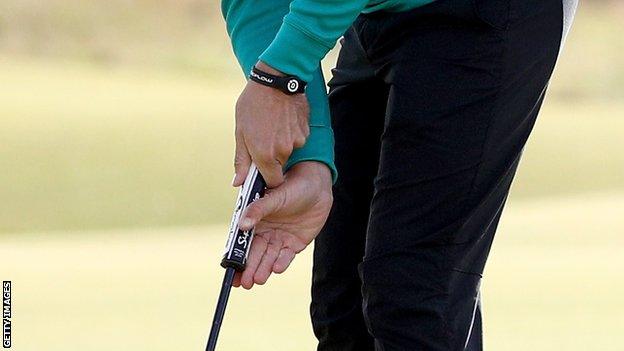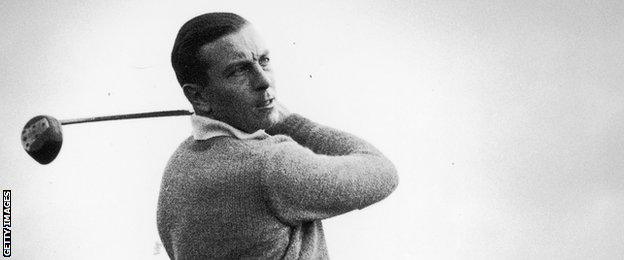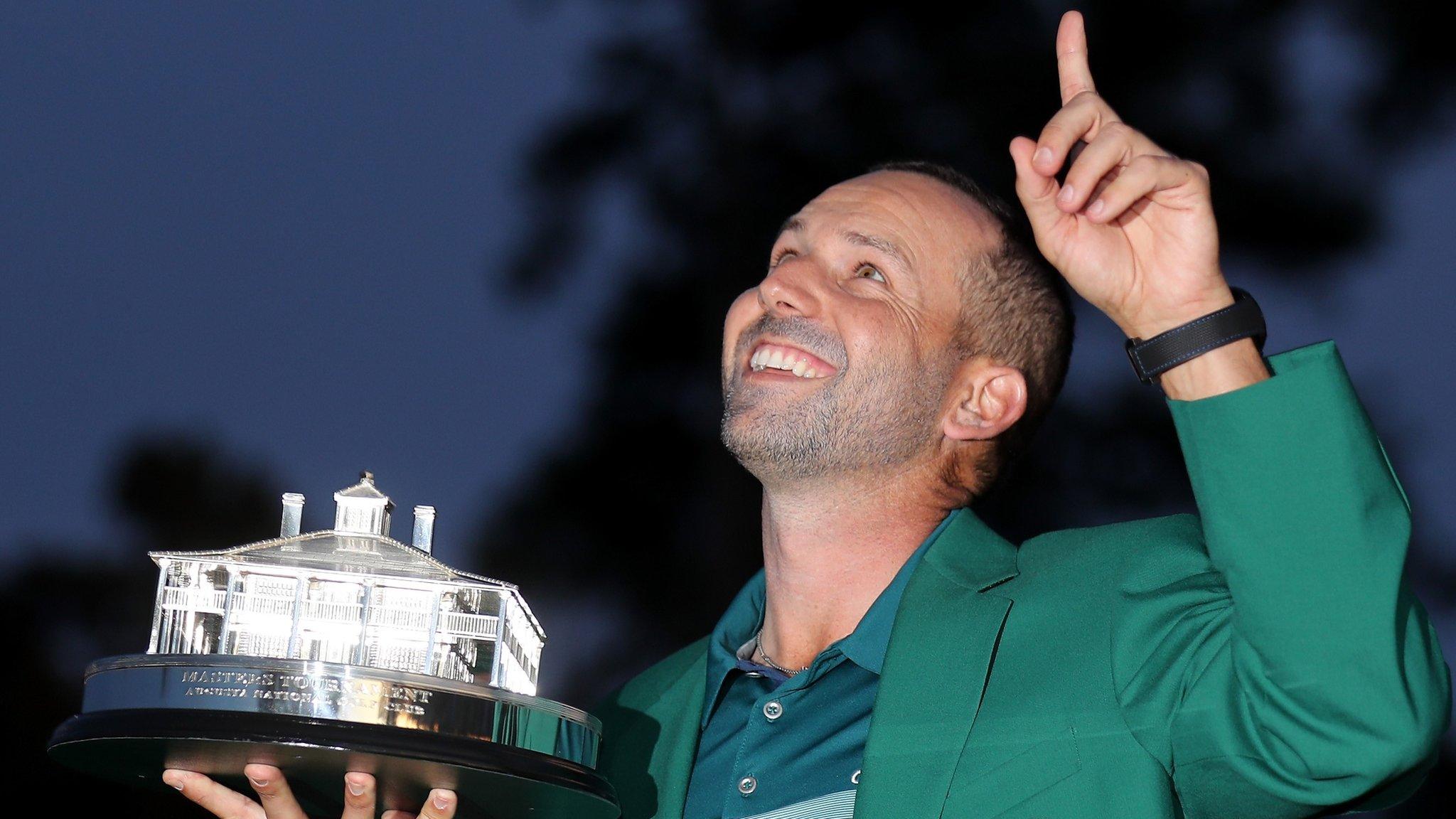Paul Trevillion: Roy of the Rovers cartoonist with the secret to putting
- Published
- comments

Paul Trevillion offered a money-back guarantee for his book 'The Perfect Putting Method'
Very few titles are won by golfers who putt badly, and no matter how supreme a player's ball striking is, such prowess will always be undone by a missed three-footer.
It is little wonder Rory McIlroy is being driven to distraction trying to settle upon a new putter as he heads into the meat of the 2017 season.
Last week in Connecticut, the Northern Irishman used three different models. And, in acknowledging that his best performance on the greens came on Sunday when he scored a six-under-par 64, he still admitted the standard of his putting was only "average".
On the same day, a 21-year-old Englishman called Harry Ellis knocked in putt after putt to come from four down with five to play to win the Amateur Championship at Royal St George's.
His sudden-death play-off triumph against Australia's Dylan Perry gave the Hampshire youngster a place at next month's Open at Royal Birkdale, as well as spots in the fields for the 2018 Masters and US Open.

Tommy Fleetwood is one of the highest-profile proponents of a split-hand grip on the greens
The week before Ellis' victory, another Englishman, Tommy Fleetwood, came close to winning the US Open at Erin Hills. The Southport player was fourth in a performance notable for his assured display on the greens.
At the Masters in April, Sergio Garcia's efficiency with the putter helped land the Spaniard his first major title, denying Olympic champion Justin Rose in a play-off for the Augusta title.
Ellis, Fleetwood, Garcia and Rose have one thing in common on the greens. They use a split-handed pencil-style grip to wield the short stick.
In doing so they prove putting is an art rather than a science.
And no-one is celebrating their success more than a highly talented English octogenarian who claims to have invented this style more than 50 years ago.
Sports artist Paul Trevillion is the man responsible for the Roy of the Rovers cartoons and a string of newspaper strips, including the famous Gary Player instruction series syndicated globally to about 15,000 different papers.
This work with the South African great helped fuel Trevillion's passion for golf. The 83-year-old actually gave up the sport when he missed a four-foot putt for an eagle at Enfield Golf Club back in the 1960s.

Paul Trevillion is so confident in his putting technique that he included this quote
"I thought, 'you can't miss from four feet', and I started to study what I did wrong," Trevillion told BBC Sport. "I realised it was the left hand that was blocking and that I didn't hold a pencil with two hands.
"If I tried to draw a straight line the way I was holding a putter, I couldn't do it. I could do a reasonably straight line but not a perfect straight line.
"So I thought, 'no, take the left hand out'. It allows the right hand to take the ball through on a straight line. That's all you need to do."
So convinced was Trevillion that he had found the secret to putting, he tried to convince all and sundry of his discovery. His theory was largely rejected and he was referred to as "the putter nutter".
"I was getting on everyone's nerves so eventually I let it go," Trevillion told me. "I took the advice of [former golfer] Peter Alliss, who said 'look Paul, if you continue to preach, it will never be used and people will say you're only an artist, so forget it'."
But three-time Open champion Sir Henry Cotton did see merit in the method and urged golfers to "Give this Trevillion putting method an extensive trial".
However, it was only in America that he gained any traction. Trevillion was invited to tour the US to demonstrate his split-grip idea and at one stage this involved a putting contest with the mighty Billy Casper.

Sir Henry Cotton used the pencil grip to help him win three Claret Jugs in 1934, 1937 and 1948
"There were 12 balls around the hole. Billy was one of the top three putters in the world at the time and he knocked in 10," Trevillion said.
"Then they put them all back up for me and I told them to just put up 11. I told them I didn't need 12 and I knocked all 11 into the hole."
In his time in the US, Trevillion made himself a dollar millionaire and won putting bets with people prepared to throw in their car keys to up the stakes.
His website still carries the boast "sink 1,000 and I will sink 1,001".
The Englishman wrote books on his technique, saying: "An artist never gets the yips. I aim at the hole and draw a straight line.
"Too often on TV you hear, 'he pushed the putt'… an artist never pushes a pencil."
To this day he maintains it is impossible to miss a putt inside four foot using his method, aiming straight at the hole regardless of borrow. This might not take account of modern green speeds, but he is adamant the technique is foolproof.
Seeing Garcia win the Masters was the crowning moment for someone who believes he was thinking 50 years ahead of his time on how to conquer golf's most maddening frustration.
"Have you ever seen a footballer score a goal and take his shirt off and run around the pitch? That's what I did, I ran out on the street," he said.
"I promise you, I was in tears. It was when Garcia won the Masters and they called it 'the pencil grip'."
The Spaniard had clarified this terminology back in 2014 with a Twitter reply to the renowned putting exponent Ken Brown, who had sought explanation on the difference between "claw" and "pencil" grips.
Garcia tweeted: "Claw: fingers are more on top of the grip. Pencil: fingers are more on the side of the grip. I prefer the pencil grip!"
Which was vindication enough for Trevillion, who believes Fleetwood and the amateur Ellis are the best exponents of the method.
"They've got it about 90% right," he said.
"I watched Harry, he was four down with five to play and he had to hole the putts. He holed them.
"Fleetwood does it terrifically, Garcia's not quite so good but young Harry is the best."
So could the split-grip pencil method be the answer to McIlroy's putting woes?
Never would I feel qualified to make such a suggestion to a golfer of his immense talent, but I know a man who would.
- Published19 June 2017

- Published12 June 2017
- Published10 April 2017
